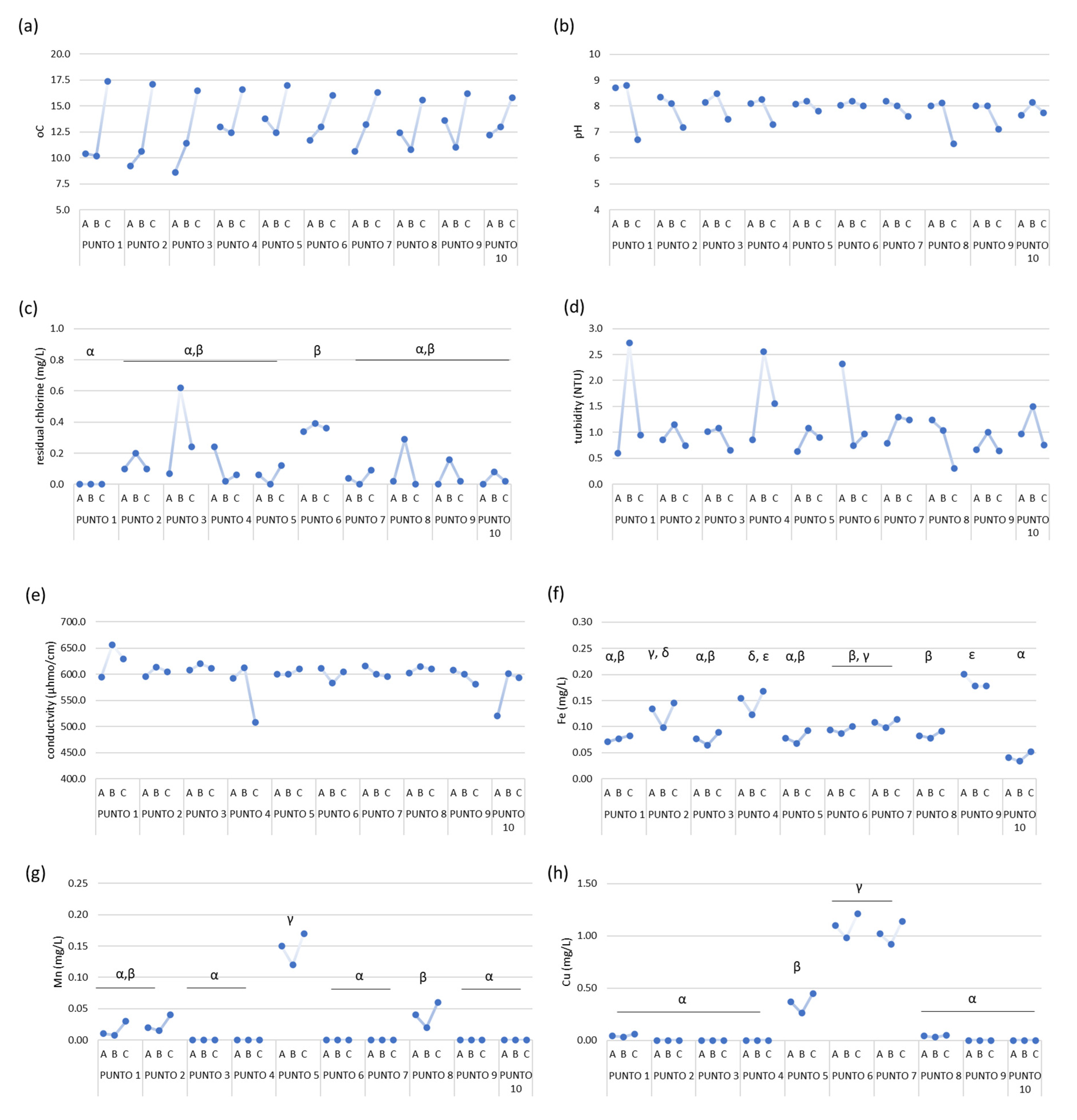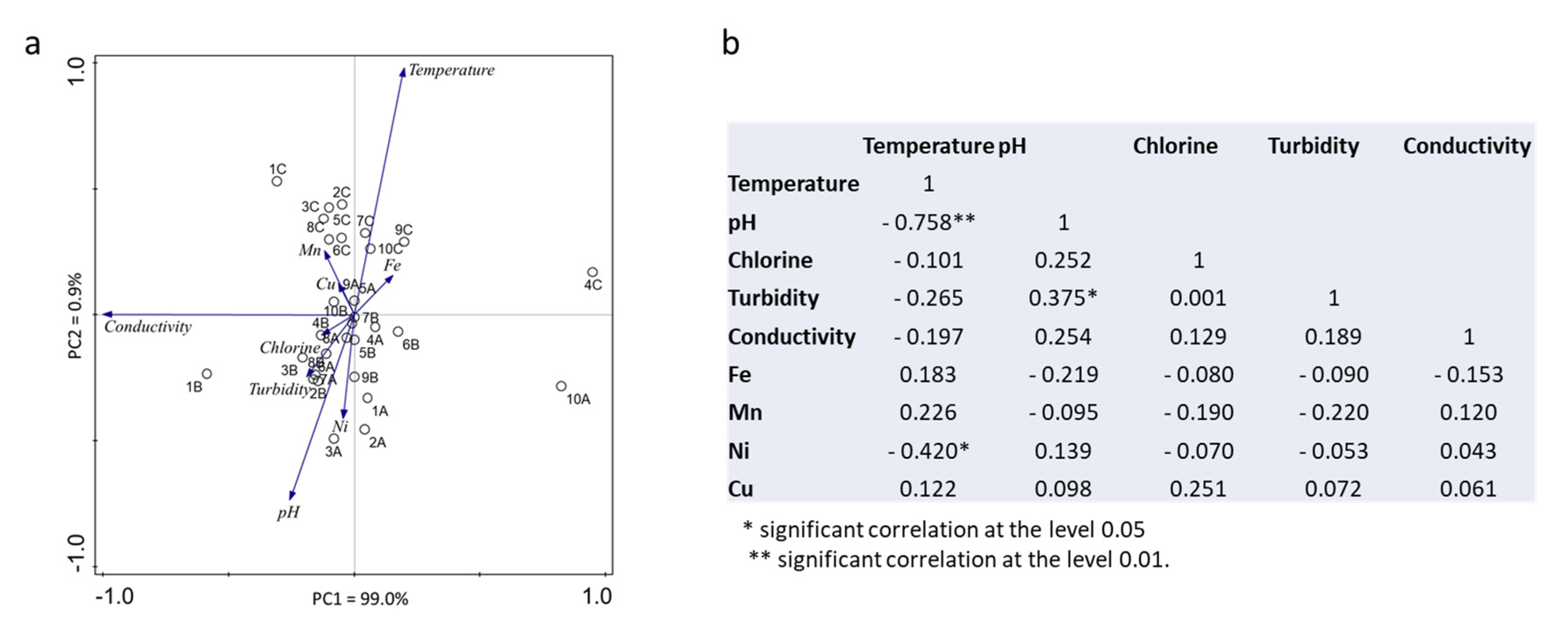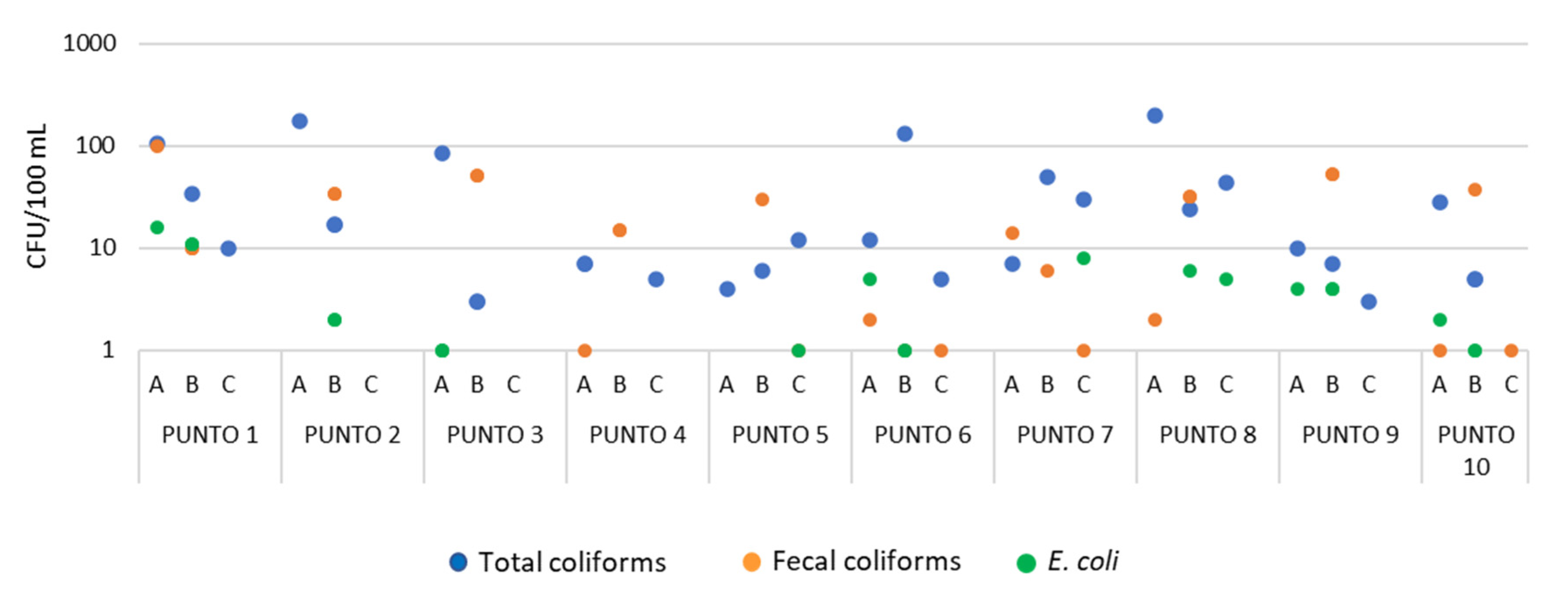Quality Control of Drinking Water in the City of Ilave, Region of Puno, Peru
Abstract
:1. Introduction
2. Materials and Methods
2.1. Delimitation of the Study and Sampling
2.2. Evaluated Parameters
2.3. Statistical Analyses
3. Results
3.1. Physical-Chemical Parameters
3.2. Microbiological Analysis
4. Discussion
5. Conclusions
Author Contributions
Funding
Data Availability Statement
Acknowledgments
Conflicts of Interest
References
- Cunliffe, D.; Bartram, J.; Briand, E.; Chartier, Y.; Colbourne, J.; Drury, D. Water Safety in Buildings; WHO Library: Geneva, Switzerland, 2011.
- World Health Organization. Guidelines for Drinking-Water Quality, 4th ed.; World Health Organization: Geneva, Switzerland, 2011.
- Trevett, A.F.; Carter, R.C. Targeting Appropriate Interventions to Minimize Deterioration of Drinking-water Quality in Developing Countries. J. Health Popul. Nutr. 2008, 26, 125–138. [Google Scholar]
- Prüss-Ustün, A.; Bartram, J.; Clasen, T.; Colford, J.M., Jr.; Cumming, O.; Curtis, V.; Bonjour, S.; Dangour, A.D.; de France, J.; Fewtrell, L.; et al. Burden of disease from inadequate water, sanitation and hygiene in low- and middle-income settings: A retrospective analysis of data from 145 countries. Trop. Med. Int. Health 2014, 19, 894–905. [Google Scholar] [CrossRef]
- Morales López, D.N.; Montero Fernández, I.; Saravia Maldonado, S.A.; Acosta Díaz, F.L.; Beltran Alemán, L.A. Indicator of Quality of Water for Human Consumption in the Community El Comején, Masaya (Nicaragua). J. Agric. Sci. 2019, 11, 176. [Google Scholar]
- Propato, M.; Uber, J.G. Vulnerability of Water Distribution Systems to Pathogen Intrusion: How Effective Is a Disinfectant Residual? Environ. Sci. Technol. 2004, 38, 3713–3722. [Google Scholar] [CrossRef]
- World Health Organization. Regional Office for Europe, WHO Advisory Group on Integrated Surveillance of Antimicrobial Resistance (AGISAR). In Critically Important Antimicrobials for Human Medicine: Ranking of Antimicrobial Agents for Risk Management of Antimicrobial Resistance Due to Non-Human Use, 5th ed.; World Health Organization: Copenhagen, Denmark, 2017. [Google Scholar]
- Farooq, S.; Hashmi, I.; Qazi, I.A.; Qaiser, S.; Rasheed, S. Monitoring of Coliforms and chlorine residual in water distribution network of Rawalpindi, Pakistan. Environ. Monit. Assess. 2008, 140, 339–347. [Google Scholar] [CrossRef]
- Munavalli, G.R.; Mohan Kumar, M.S. Water quality parameter estimation in a distribution system under dynamic state. Water Res. 2005, 39, 4287–4298. [Google Scholar] [CrossRef] [PubMed]
- Olivieri, V.P.; Snead, M.C.; Krusé, C.W.; Kawata, K. Stability and effectiveness of chlorine disinfectants in water distribution systems. Environ. Health Perspect. 1986, 69, 15–29. [Google Scholar] [CrossRef]
- Lee, L.; Lu, C.; Kung, S.L. Spatial Diversity of Chlorine Residual in a Drinking Water Distribution System. J. Environ. Eng. 2004, 130, 1263–1268. [Google Scholar] [CrossRef]
- Hernández-Vasquéz, A.; Rojas-Roque, C.; Marques Sales, D.; Santero, M.; Bendezu-Quispe, G.; Barrientos-Gutiérrez, T.; Miranda, J.J. Inequalities in access to safe drinking water in Peruvian households according to city size: An analysis from 2008 to 2018. Int. J. Equity Health 2021, 20, 133. [Google Scholar] [CrossRef] [PubMed]
- Geldreich, E.E. Microbial Quality of Water Supply in Distribution Systems; CRC Press: Boca Raton, FL, USA, 1996; 512p. [Google Scholar]
- Lee, E.J.; Schwab, K.J. Deficiencies in drinking water distribution systems in developing countries. J. Water Health 2005, 3, 109–127. [Google Scholar] [CrossRef] [PubMed]
- Bigoni, R.; Sorlini, S.; Collivignarelli, M.C.; Berbenni, P. Drinking water quality assessment and corrosion mitigation in the hospital water supply system of Chacas Village (Peru). Rev. Ambiente Água. 2014, 9, 379–389. [Google Scholar]
- Gil, A.I.; Lanata, C.F.; Hartinger, S.M.; Mäusezahl, D.; Padilla, B.; Ochoa, T.J.; Lozada, M.; Pineda, I.; Verastegui, H. Fecal contamination of food, water, hands, and kitchen utensils at the household level in rural areas of Peru. J. Environ. Health 2014, 76, 102–106. [Google Scholar] [PubMed]
- Heitzinger, K.; Rocha, C.A.; Quick, R.E.; Montano, S.M.; Tilley, D.H.; Mock, C.N.; Carrasco, A.J.; Cabrera, R.M.; Hawes, S.E. “Improved” But Not Necessarily Safe: An Assessment of Fecal Contamination of Household Drinking Water in Rural Peru. Am. J. Trop. Med. Hyg. 2015, 93, 501–508. [Google Scholar] [CrossRef] [Green Version]
- Miranda, M.; Aramburú, A.; Junco, J.; Campos, M. Situación de la calidad de agua para consumo en hogares de niños menores de cinco años en Perú, 2007–2010. Rev. Peru. Med. Exp. Salud. Publica 2010, 27, 506–511. [Google Scholar] [CrossRef]
- Oswald, W.E.; Lescano, A.G.; Bern, C.; Calderon, M.M.; Cabrera, L.; Gilman, R.H. Fecal Contamination of Drinking Water within Peri-Urban Households, Lima, Peru. Am. J. Trop. Med. Hyg. 2007, 77, 699–704. [Google Scholar] [CrossRef] [PubMed]
- INEI. Encuesta Demográfica y de Salud Familiar. In ENDES 2018; INEI: Lima, Peru, 2019. [Google Scholar]
- MIDIS. Plan Multisectorial de Lucha Contra la Anemia [Internet]. 2018. Available online: https://cdn.www.gob.pe/uploads/document/file/307159/plan-multisectorial-de-lucha-contra-la-anemia-v3.pdf (accessed on 10 October 2021).
- MINSA. Análisis de la Situacion de la Enfermedad Diarreica Aguda y Colera en el Peru; MINSA: Lima, Peru, 2000; 41p.
- MINSA. Documento Técnico: Plan Nacional para la Reducción y Control de la Anemia Materni Infantil y la Desnutrición Crónica Infantil en el Peru: 2017–2021 [Internet]. 2017. 65p. Available online: http://bvs.minsa.gob.pe/local/MINSA/4189.pdf (accessed on 20 April 2022).
- MINSA. Protocolo de Procedimientos para la Toma de Muestras, Preservación, Conservación, Trasporte, Almacenamiento y Recepción de Agua para Consumo Humano [Internet]. 2015. 41p. Available online: http://www.digesa.minsa.gob.pe/normaslegales/normas/rd_160_2015_digesa.pdf (accessed on 20 April 2022).
- MINSA. Reglamento de la Calidad del Agua para Consumo Humano [Internet]. 2011. 46p. Available online: http://www.digesa.minsa.gob.pe/publicaciones/descargas/Reglamento_Calidad_Agua.pdf (accessed on 20 April 2022).
- LeChevallier, M.W.; Welch, N.J.; Smith, D.B. Full-scale studies of factors related to coliform regrowth in drinking water. Appl. Environ. Microbiol. 1996, 62, 2201–2211. [Google Scholar] [CrossRef] [PubMed]
- Ferro Mayhua, F.P.; Ferró Gonzales, P.F.; Ferró Gonzáles, A.L. Distribución temporal de las enfermedades diarreicas agudas, su relación con la temperatura y cloro residual del agua potable en la ciudad de Puno, Perú. Rev. Investig. Altoandinas 2019, 21, 69–80. [Google Scholar] [CrossRef]
- Dai, Z.; Sevillano-Rivera, M.C.; Calus, S.T.; Bautista-de los Santos, Q.M.; Eren, A.M.; van der Wielen, P.W.J.J.; Ijaz, U.Z.; Pinto, A.J. Disinfection exhibits systematic impacts on the drinking water microbiome. Microbiome 2020, 8, 42. [Google Scholar] [CrossRef]
- Kumpel, E.; Nelson, K.L. Intermittent Water Supply: Prevalence, Practice, and Microbial Water Quality. Environ. Sci. Technol. 2016, 50, 542–553. [Google Scholar] [CrossRef]
- Bivins, A.; Lowry, S.; Wankhede, S.; Hajare, R.; Murphy, H.M.; Borchardt, M.; Labhasetwar, P.; Brown, J. Microbial water quality improvement associated with transitioning from intermittent to continuous water supply in Nagpur, India. Water Res. 2021, 201, 117301. [Google Scholar] [CrossRef]
- Coelho, S.T.; James, S.; Sunna, N.; Abu Jaish, A.; Chatila, J. Controlling water quality in intermittent supply systems. Water Supply 2003, 3, 119–125. [Google Scholar] [CrossRef]
- Rubino, F.; Corona, Y.; Pérez, J.G.J.; Smith, C. Bacterial Contamination of Drinking Water in Guadalajara, Mexico. Int. J. Environ. Res. Public Health 2018, 16, 67. [Google Scholar] [CrossRef] [PubMed]
- Matsinhe, N.P.; Juízo, D.L.; Persson, K.M. The Effects of Intermittent Supply and Household Storage in the Quality of Drinking Water in Maputo. VATTEN—J. Water Manag. Res. 2014, 70, 51–60. [Google Scholar]
- Kumpel, E.; Nelson, K.L. Comparing microbial water quality in an intermittent and continuous piped water supply. Water Res. 2013, 47, 5176–5188. [Google Scholar] [CrossRef] [PubMed]
- Karikari, A.Y.; Ampofo, J.A. Chlorine treatment effectiveness and physico-chemical and bacteriological characteristics of treated water supplies in distribution networks of Accra-Tema Metropolis, Ghana. Appl. Water Sci. 2013, 3, 535–543. [Google Scholar] [CrossRef] [Green Version]




| Sampling Point | Sampling Points Designation | Address: Street/Av. | Georeference UTM | Type of Sampling Point | Water Availability (h/Day) | ||
|---|---|---|---|---|---|---|---|
| East | North | Altitude | |||||
| PUNTO 1 | Rio | Old Bridge | 432798 | 8221380 | 3645 | River | n.a. |
| PUNTO 2 | Primera Vivienda | St. Zepita | 432572 | 8221401 | 3874 | Household | 4 |
| PUNTO 3 | Barrio Santa Barbara | St.16 de Agosto | 432505 | 8221462 | 3866 | Household | 4 |
| PUNTO 4 | Barrio San Sebastian | St. San Sebastian | 432311 | 8220792 | 3847 | Household | 4 |
| PUNTO 5 | Complejo | St. Desaguadero | 432417 | 8222090 | 3843 | Household | 8 |
| PUNTO 6 | Plaza De Armas | St. 28 de Julio | 432017 | 8222145 | 3868 | Household | 8 |
| PUNTO 7 | Barrio San Martin | St. Pachacutec | 432556 | 8221979 | 3867 | Household | 8 |
| PUNTO 8 | Cusupi | Av. Republica | 431933 | 8222027 | 3860 | Household | 8 |
| PUNTO 9 | Terminal Terrestre | Av. Puno | 431109 | 8221753 | 3866 | Household | 8 |
| PUNTO 10 | Barrio Alto Alianza | Av. Primavera | 431158 | 8221189 | 3857 | Household | 8 |
| Parameter | Legal Limit (DS N° 031-2010-SA, MINSA 2011) |
|---|---|
| Physical-chemical | |
| turbidity | 5 NTU |
| residual chlorine | 250 mg Cl−/L |
| temperature | n.a. |
| conductivity (25 °C) | 1500 μhmo/cm |
| pH | 6.5–8.5 |
| Microbiological | |
| total coliforms | 0 CFU/100 mL at 35 °C |
| fecal coliforms and E. coli | 0 CFU/100 mL at 44.5 °C |
| Heavy metals | |
| Zn | 3.0 mg/L |
| Mn | 0.4 mg/L |
| Ni | 0.02 mg/L |
| Fe | 0.3 mg/L |
| Cu | 2.0 mg/L |
Publisher’s Note: MDPI stays neutral with regard to jurisdictional claims in published maps and institutional affiliations. |
© 2022 by the authors. Licensee MDPI, Basel, Switzerland. This article is an open access article distributed under the terms and conditions of the Creative Commons Attribution (CC BY) license (https://creativecommons.org/licenses/by/4.0/).
Share and Cite
Ferro, P.; Rossel-Bernedo, L.J.; Ferró-Gonzáles, A.L.; Vaz-Moreira, I. Quality Control of Drinking Water in the City of Ilave, Region of Puno, Peru. Int. J. Environ. Res. Public Health 2022, 19, 10779. https://doi.org/10.3390/ijerph191710779
Ferro P, Rossel-Bernedo LJ, Ferró-Gonzáles AL, Vaz-Moreira I. Quality Control of Drinking Water in the City of Ilave, Region of Puno, Peru. International Journal of Environmental Research and Public Health. 2022; 19(17):10779. https://doi.org/10.3390/ijerph191710779
Chicago/Turabian StyleFerro, Pompeyo, Luis Jhordan Rossel-Bernedo, Ana Lucia Ferró-Gonzáles, and Ivone Vaz-Moreira. 2022. "Quality Control of Drinking Water in the City of Ilave, Region of Puno, Peru" International Journal of Environmental Research and Public Health 19, no. 17: 10779. https://doi.org/10.3390/ijerph191710779
APA StyleFerro, P., Rossel-Bernedo, L. J., Ferró-Gonzáles, A. L., & Vaz-Moreira, I. (2022). Quality Control of Drinking Water in the City of Ilave, Region of Puno, Peru. International Journal of Environmental Research and Public Health, 19(17), 10779. https://doi.org/10.3390/ijerph191710779








